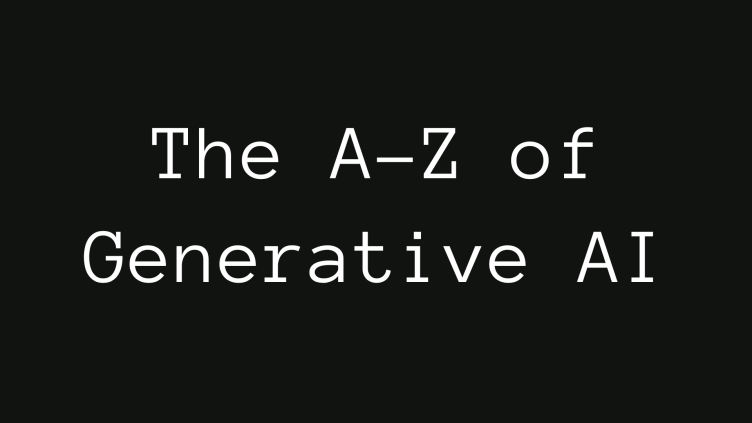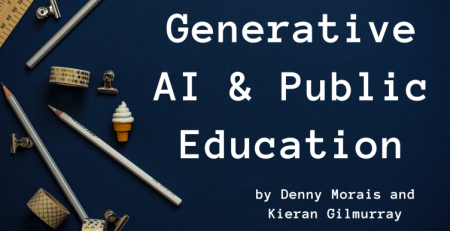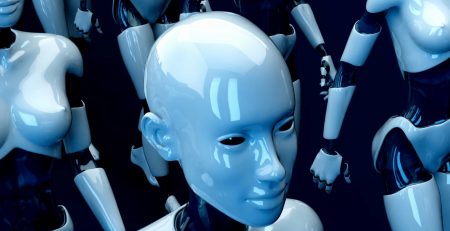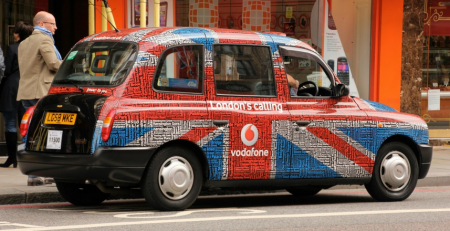The A-Z of Generative AI and ChatGPT – Chapter A
No, your job will not be replaced by Artificial Intelligence but it will be replaced by someone who knows how to use AI. AI skills are forecast to be the most highly-demanded skills of the next decade. Generative AI is a step change in the evolution of artificial intelligence.
As companies rush to understand, adopt and implement Generative AI , understanding the technology’s potential to deliver value for the individual, economy and global economy at large will help shape critical personal and business decisions.
Take your understanding, productivity, employability, and business to the next level by reading my carefully curated series on Generative AI.

Welcome to the A-Z of Generative AI where each week I will give you an explanation of every aspect of this exciting new technology beginning with the letter A and ending with the letter Z. You will learn all there is to know about Generative AI in this series to rapidly level up your job prospects, your productivity, and your business.
Each article will clearly explain Generative AI terms so you can master this hot technology.
You will go from ZERO to HERO in a matter of weeks catapulting your knowledge and job prospects into a whole new stratosphere.
I will give you a MASSIVE unbelievable bonus offer for FREE i.e., 60+ of the very best Generative AI articles, images, and research topics on the planet. Each has been carefully selected and curated for your benefit.
And that is not all. I will also provide you with example prompts to hyperscale your productivity.
And give you links to the very best consulting companies’ articles on Generative AI for FREE as well.
And I will also give you my and other experts’ perspectives on how Generative AI will fundamentally change the world of work as you know it.
Don’t miss out. Grab a lifetime of learning in the fastest time possible and start reading.

Generative AI, a subset of AI, has generated more interest than the launch of the iPhone and the World Wide Web combined in a much shorter time. It took ChatGPT less than 5 five days to get a million users and reached 100 million users just two months after launching.
Why is Generative AI causing such excitement❓
Because of its transformative potential. And I don’t just mean its ability to help save lives, provide real-time personalisation and conversation, predict significant events, and more from data. Traditional AI models could already do that.
Traditional AI is narrow. It performs a single or specific task, such as processing a customer churn model. In comparison, Generative AI is broad and can generate new images, music, speech, code, video, or text.
It is a technology that people are excited to use as it enables them to search, work, learn, and engage in a human-like way that is more productive and creative i.e., in natural language.
In addition, having API or screen-based access to large ‘out-of-the-box’ pre-trained foundational Large Language Models (LLMs) has opened affordable access to AI to the masses. This is extraordinary as it enables businesses to benefit from a low-margin structure that can now leveraged to get more work done.
For example, imagine a law firm with 50,000 legal documents that need to be reviewed. Currently, that work would need to be completed by an army of paralegals or lawyers making it a very expensive due diligence exercise. Generative AI now enables that same legal firm to complete this work to higher quality, for far less money and in far less time. That changes the economic model of legal firms that invest in Generative AI.
We are entering a new era of software and business – Intelligence 2.0 – where Generative AI’s capabilities and applications are limited only to our imaginations.
If you can think it and describe then Generative AI can (or will) be able to create it.
The practical implications and applications of Generative AI are exciting the business world. It has immense potential to revolutionize any field where creativity and innovation are key which is a very different business shift than ever before.
Now that is exciting.

“The world has not seen a disruption as potentially huge as Generative AI since the days of the printing press, which for the first time enabled knowledge to be democratized at scale. With Generative AI we are now seeing the democratization of “Ability” – Anyone, can do almost anything thing, almost anywhere”
Wayne Butterfield, ISG Partner and Global Lead for Augmented Intelligence
“Considering that in the near future, every college graduate will be generative AI native, organizations should anticipate delivering training and workplace experiences using AI to attract and retain this new generation of talent.”
Deloitte Digital Ensuring a Human-Cantered Approach to AI
“Using Generative AI is like having your own JARVIS from Iron Man – always ready with new ideas! Let’s say you’re running a small business and you’re trying to come up with a catchy slogan. Instead of spending hours brainstorming, you can use Generative AI to quickly generate a list of unique and creative options.
It’s like having a super-smart, creative partner who’s always on call. And the best part? You don’t need to be a tech expert to use it. This technology is designed to be user-friendly, making it a game-changer for anyone looking to boost their creativity and innovation. It’s all about turning the seemingly impossible into possible.”
Laurentiu BOGDAN, Digital & IS Director, and a self-proclaimed Generative AI enthusiast always hungry for innovation

A digital revolution was already underway. Now this has been turbocharged with the release of Generative AI. We no longer need to be data or computer scientists to change the world. Generative AI has changed the very nature of how businesses operate and deliver value. It can ‘generate’ text, speech, images, music, video, and computer code in response to a command.
When that capability is joined with a business’s own proprietary information then how businesses make money dramatically changes. Generative AI will drive efficiency and innovation across all industries at scale. What ChatGPT can enable will be greater than any existing software produced to date.
For example, today we have to spend inordinate amounts of time manually searching through applications for the most basic of data. Now, our conversational queries can be recognized and answered in milliseconds. For example, you can ask ChatGPT (and similar derivatives) to:
- List the contacts I have not called in the last 90 days.
- Create a table with my top 10 clients by customer life time value.
- Generate a professional email to [business leader] at [target company]. BUT first perform research on the [company], on the target [Business leader]. Then draft an email that incorporates both information from the research and from what it knows about the [Business leader] themselves for me to review.
- Write a humorous after-dinner speech on [TOPICS] for an event I am scheduled to be at in Dublin in September.
- What’s the next best product I can offer [customer A]?
The more direction you can provide in your prompts, the better. For example,
- You are a behavioural psychology professor who is highly respected for your intellect and writing ability. Use advanced language and explain concepts in great detail on [TOPIC] for a lecture I will deliver to second-year business students. Rewrite the class you wrote two weeks ago but add new keywords including, reciprocity and unity. Use the following sample text from a class I delivered last year and copy my style of writing and presenting [‘SAMPLE TEXT’].
But that is not what makes Generative AI exciting. Prompting offers the potential for simplicity, personalization, and democratization of all information known to humankind at minimal marginal cost by anyone. ChatGPT is similar to having an unending number of very clever interns who know everything there is to know in the world. Now enterprises can focus on generating key insights in real-time, from the vast amounts of data and information stored within them.
Generative AI had its own iPhone moment the very second OpenAI gave the world ChatGPT 3.5 in November 2022. From that moment, the democratisation of AI became a reality, putting inordinate power in the hands of the many, not just the few. This has led to a surge in creativity and innovation, and the disruption of industries (e.g., journalism, writing, medicine, mathematics, lay, translation, artists, accounting, software engineering, etc.) .
As the technology becomes more sophisticated, it will be able to automate and augment many of the tasks currently done by humans, resulting in massive disruption to roles, organizations and economies in a way we have not witnessed since the industrial revolution.
‘I knew I had just seen the most important advance in technology since the graphical user interface.’
Bill Gates upon seeing ChatGPT
ChatGPT 3.5 / 4 will significantly impact the world and catch many governments, industry leaders, and workers unawares.
The long-term implications of this technology are yet to reveal themselves but they will be significant. For example, McKinsey has predicted that AI could add up to $4.4 TRILLION to the global economy, but time will tell if that number is big enough.
Make no mistake, we have entered an exciting and tumultuous era of exponential technology and AI innovation. Where we work, and how we work, will change because the work we do will is changing with AI exponentially accelerating that change. We have reached a major junction in time.
“The development of AI is as fundamental as the creation of the microprocessor, the personal computer, the Internet, and the mobile phone,” he wrote. “It will change the way people work, learn, travel, get health care, and communicate with each other.”
Bill Gates
Governments, industries, businesses, and workers that rapidly adapt to this brave new AI world will thrive. Yet humanity needs to change. We need to urgently develop and enhance our people skills in ways that machines cannot replicate – empathy, intuition, critical thinking, adaptability, emotional and social intelligence – and learn to use AI technology to catalyse them to remain employable. Those that don’t simply will not survive.
AI won’t take your job, but someone who knows how to use AI surely will.
This series has been specifically created to help YOU learn Generative AI. That way you can stay one step ahead of the game ensuring you and your business not only survive but thrive in this mutable world.
Keen to learn more❓ Then keep reading.

Need consulting help to understand Generative AI and how you can make every role in your business 40% more productive❓
Then book a FREE 30 minute introductory call to discuss your specific business’s, Generative AI needs – click here.

1. Act Like or Act As 🅰
“Act like or Act As” in the context of generative AI prompts refers to the instruction given to a generative AI model to simulate the behaviour, style, or characteristics of a specific entity, such as a well-known artist, writer, or musician.
It prompts the model to generate content that closely resembles the patterns, traits, and artistic expressions associated with them.
For example, a Generative AI model could be asked to “act like Vincent Van Gogh” when creating paintings. In response, the model would leverage its training on Van Gogh’s artwork to produce new paintings that mimic his iconic brush strokes, use of colour, and overall artistic flair.
Similarly, in writing, a prompt like “act like Shakespeare” would instruct the generative AI model to generate text that emulates the language, poetic meter, and literary style of the famous playwright.

Example of Act As from Instagram
2. Active Learning 🅰
Act like is a machine learning technique where the algorithm selects the most informative data points for labelling by actively querying an expert or using a predefined strategy. This iterative process reduces the labelling effort while improving model performance.
For example, a medical research team uses active learning to train an AI model to identify cancerous cells in pathology slides. The algorithm asks an expert to label the most uncertain or ambiguous cells, improving the model’s accuracy over time.
3. Adversarial Networks (GANs) 🅰
Adversarial Networks, or GANs, are like an artistic duo in a competitive game. GANs consist of two neural networks, the generator, and the discriminator. The generator creates new data, while the discriminator tries to distinguish real data from generated data. This competition between the two networks leads to the generation of realistic and high-quality content. This constant back-and-forth improves the generator’s ability to produce realistic data, making GANs popular for tasks like image and video synthesis.
For example, an advertising company might use GANs to generate realistic images of products that do not exist yet. The generator creates various product designs, while the discriminator provides feedback, resulting in compelling visuals for marketing campaigns.
Prompt: “Create innovative product designs for our [ABC] advertising campaigns, generating unique visuals that capture consumer [PERSONA’s] (and a detailed description of a persona could also be fed into the model) attention”
4. Artificial Intelligence (AI) 🅰
Artificial Intelligence refers to the simulation of human intelligence in machines that are programmed to think, learn, and solve problems like humans. Generative AI is a subset of AI that focuses on creating new content, such as images, text, or music, using neural networks and other algorithms.
With some training, a Generative AI model could complete some advanced work normally completed by people. For example, AI models could create game levels, characters, and storylines, streamlining game development for a gaming company. This has the potential to speed up games production dramatically improving the output, productivity, and cost of games development.
5. API – Application Program Interface 🅰
What is an API❓ An API, or application programming interface, is a set of defined rules that enable different applications to communicate with each other. It acts as an intermediary layer that processes data transfers between systems, letting companies open their application data and functionality to external third-party developers, business partners, and internal departments within their companies.
The definitions and protocols within an API help businesses connect the many different applications they use in day-to-day operations, which saves employees time and breaks down silos that hinder collaboration and innovation.
Companies can connect to OpenAI using APIs to build their own applications or gain access to OpenAI’s model to develop their applications e.g., a Conversational AI platform can be securely connected to internal data sources and Microsoft’s OpenAI model to develop exceptional human-like conversations that help augment business talent.
🔗Useful web link: What is an Application Programming Interface (API)? | IBM

This article series is open for sponsorship. Contact me if you wish to sponsor a chapter or the entire series – https://calendly.com/kierangilmurray/connect-and-chat
6. Automatic Text Summarization using Generative AI 🅰
AI models can extract key points from lengthy text documents, providing concise and informative summaries.
For example, a research institute aiming to utilize AI for summarizing scientific papers could prompt AI for text summarization. Researchers could ask Bing AI “generate concise summaries of the following scientific papers – hyperlink – hyperlink – hyperlink -” helping researchers to quickly grasp the key findings aiding researchers to rapidly extract essential information from lengthy scientific articles efficiently.
Similarly, you could imagine a high court judge, faced with a mountain of trial documents asking a generative AI infused LLM legal model to summarise the legal arguments presented to them and validate that against case law.
7. Automated Language Translation using Generative AI 🅰
AI models can translate text between languages, fostering effective communication in a globalized world.
For example, a multinational corporation might plan to use AI to translate their internal documents. To initiate AI for language translation, they could ask ChatGPT, “Translate the following documents accurately and efficiently, ensuring smooth cross-border communication so that [PERSONA] can easily understand them”
8. AI-Powered Virtual Assistants 🅰
AI models can perform various tasks, such as scheduling meetings, answering queries, or managing to-do lists.
For example, an executive might seek to use Conversational AI to manage their daily tasks efficiently. To prompt AI as a virtual assistant, they could ask ChatGPT, “Organize my schedule, answer my emails, and provide reminders to optimize my productivity”
If they are uncertain as to what the Generative AI application might help with, they could prompt it i.e., “What strategies can I adopt to streamline my daily tasks and enable me to focus on strategic decision-making?”
9. Anomaly Detection with Generative AI 🅰
Anomaly detection AI models can learn normal patterns from data and identify anomalies, aiding in fraud detection or fault diagnosis.
For example, a cybersecurity firm could use AI to detect fraudulent transactions in financial transactions based on historical data patterns.
10. Adaptive Learning in Generative AI 🅰
Adaptive learning helps Generative AI continuously improve its output by learning from user feedback and adapting its behaviour.
For example, a language learning app might implement AI for personalized tutoring. They could ask AI to adapt its language lessons based on individual learner’s progress and feedback ensuring personalized and effective tutoring for each user.

If you would like over 60 FREE Generative AI resources, then add your email address to this post and then ♻️ repost this article.
Once you have done that I will share a link to 60-plus documents and images that have been specifically curated to get you from AI ZERO to HERO in no time at all.

You can pretty much ask ChatGPT anything – so if you have an idea then run it through its prompt engine. You may just be wonderfully surprised with the answer. The more specific you can be in your prompting, the better.
‘Propose a business idea for a sustainable, eco friendly fashion business based in Camden in London. Consider the target market, potential revenue streams and staffing required to operate the store 7 days a week from 9am to 7pm – Sunday to Monday’

Some of the best Generative AI articles from some of the best sources on the internet.
- McKinsey What is Generative AI?
- HBR – Generative AI will change you business – here is how to adapt
- McKinsey 68 Page Special Report – The economic potential of generative AI: The next productivity frontier
- ERP Today Generative AI for the enterprise – Pascal BORNET and Kieran Gilmurray

Every single role you can think of will be impacted by Generative AI. In fact understanding how to interact with ChatGPT will soon be an essential key skill.
Below are 5 roles that begin with the letter A with an example prompt each massively boosting role productivity.
1. Accountant. Accountants manage financial records and prepare reports.
- Prompt: Conduct a thorough audit of a company’s financial transactions to ensure accuracy and compliance.
- Prompt: Create a financial forecasting model to help clients plan for future expenses and revenue growth.
2. Architect. Architects design and plan buildings and structures.
- Prompt: Develop a detailed architectural blueprint for a sustainable and energy-efficient office building.
- Prompt: Design an innovative urban park that promotes community engagement and environmental preservation.
Advertising Manager. Advertising managers oversee promotional campaigns.
- Prompt: Create a marketing strategy for a new product launch, utilizing digital and traditional advertising channels.
- Prompt: Analyze the performance metrics of previous advertising campaigns and propose optimization strategies.
3. Attorney. Attorneys provide legal counsel and representation.
- Prompt: Prepare a compelling legal argument to present in court for a high-profile case.
- Prompt: Research and analyse relevant case law to support a client’s defence in a complex lawsuit.
4. Aerospace Engineer. Aerospace engineers design and develop aircraft and spacecraft.
- Prompt: Design an innovative propulsion system for a next-generation space exploration vehicle.
- Prompt: Conduct a structural analysis of an aircraft wing to optimize its performance and efficiency.
By using these prompts, professionals in each role can engage in tasks that augment their skills and expertise, leading to improved productivity and success in their respective careers.
You may not lose your role to Generative AI but you will lose it to someone who knows how to use AI.












Leave a Reply